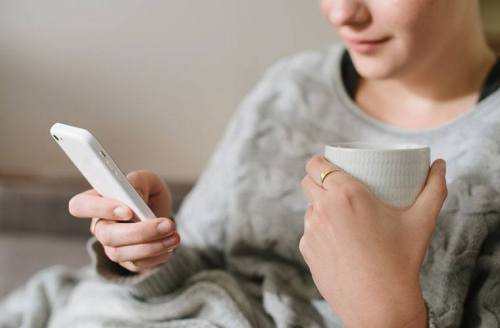This week on The Plus Factor, we’re talking about all the new ways people are going to therapy. The tried-and-true couch method is no longer the only way to get help. Now, people are texting, video-chatting, and even running with their therapists. But are all the changes for the better? Here, experts sound off on the evolution of the mental health world, and what it means for you.
For decades, “therapy” has meant something pretty specific: booking an appointment and meeting up with a trained professional face-fo-face. The whole Freudian lying-on-the-couch idea may be outdated, but the idea of therapy as an in-person interaction has always been there. But in the past few years, whole new methods have popped up that have raised some pretty interesting questions. For example, is it acceptable to shoot your therapist the occasional text asking for help? And what about social media: Is it okay to be Facebook friends with your therapist or follow him or her on Instagram?
To gain some insight, I talked to several mental health professionals offering cutting edge treatments as well as Well+Good Council member Drew Ramsey, MD—a Columbia University-based psychiatrist who keeps up on the latest trends (especially nutrition) but is still very much a “couch” therapist. What follows is an inside look at the evolution of getting help, and whether it’s changing for better or for worse.
Keep reading to find out what the future of therapy holds.

More ways to connect means more access for people who need it
Traditional therapy is great—for those who can afford it, says Roni Frank, who co-founded Talkspace, which connects people to therapists via text or videoing. “Traditional therapy is a 2 percent service,” she says. “If you have the money, the time, and the access, it’s great.” It was while studying psychology to become a trained clinician that she first became aware of the lack of access problem: “I realized the mental health system in America was broken,” she says. “Recent studies show that one in five Americans suffer from mental health issues each year, which is roughly 42 million people. However, 70 percent of those 42 million Americans have no access to services at all. This disparity caught my attention and I immediately felt compelled to be part of the solution to this problem.” She was definitely on to something: So far, half a million people have used Talkspace, which has a network of 2,000 trained therapists.
As she explains it, there are three major barriers for people to get the help they need: Cost (which she says is the biggest one), immediate access (having to wait a prolonged period for an appointment), or stigma. “Maybe it’s a sex issue or you want to come out as gay. Talking about something intimidating can be easier over text than looking into someone’s eyes,” Frank says.
“Traditional therapy is a 2 percent service.” —Roni Frank, Talkspace co-founder
Jeremy Fischbach, a Princeton psychology graduate, launched his app Happy with a similar passion for giving people easier ways to connect, right away. Users in need of emotional support can use the app to call a trained listener. Though the “listeners” aren’t trained therapists, their goal isn’t to give advice—it’s to provide emotional support, which Fischbach says is a vital human need. “We believe emotional support is the foundation of mental health, and believe strongly that a lot of everyday people are extremely good at providing emotional support,” he says. But rather than a replacement for traditional therapy, he sees it as a companion to it.
But is it healthy to have a therapist or emotional support at your fingertips? What about the boundaries between therapists and clients? Frank, for one, isn’t worried. “Our therapists are trained professionals and can tell when someone is developing an unhealthy dependency. They know how to set boundaries,” she says.
“I really insist on seeing people in person for an evaluation because that’s the most accurate way to engage with clients, is to sit with them.” —Dr. Drew Ramsey
“I think new technological tools in the hands of well-trained mental health clinicians are incredible,” says Dr. Ramsey. ” The idea that if someone is in crisis, I can have a face-to-face talk with them, no matter where they are in the US is great.” But he also says he would never text a client he had never met with. “I really insist on seeing people in person for an evaluation because that’s the most accurate way to engage with clients, is to sit with them. If you start texting with people in a clinical capacity and you’ve never met them, it’s really irresponsible because someone’s mental health is in your hands.” He explains that even talking on the phone, it can be hard to figure out how someone is reacting to something he’s said, or even if they are laughing or crying.
He sees apps like Happy and other “hotline methods” as serving a different need than ongoing therapy. “A hotline is like an emergency room. Treatment is really about going deeper and understanding the patterns of a crisis.”

How therapy is becoming more integrative
Incorporating tech isn’t the only way therapy has evolved. Run Walk Talk founder Sepideh Saremi runs or walks with her clients, a method aptly calling running therapy. “I find that patients are much calmer and they open up to me about issues that would take them longer to reveal in traditional therapy,” she says. It’s sort of like bringing up a tricky subject with someone when you’re driving with them in the car—the lack of eye contact makes the conversation less intimidating.
“Sometimes sitting can feel very similar to when you were traumatized, that feeling of being trapped or disassociating. Running or walking can counter that.” —Run Walk Talk founder Sepideh Saremi
She especially finds it beneficial for people who have experienced trauma. “Sometimes sitting can feel very similar to when you were traumatized, that feeling of being trapped or disassociating,” Saremi says. “Running or walking can counter that and allow you to talk about what happened to you. It’s pretty powerful.”
Another way to work on your brain via your body? Dr. Ramsey incorporates food into his clinical practice, teaching his clients how to cook meals that will help treat their depression. In California, non-profit Groceryships teaches people how to cook with healthy food in a group therapy model. “There is a correlation between your likelihood to eat unhealthy food and your stress level and also childhood trauma,” founder Sam Polk says. “Groceryships is about equipping people with tools and knowledge, but also with the social and emotional support that is so critical to maintaining a healthy lifestyle.”

More data to inform better treatments
Not only are there more ways for people to get therapy and emotional support, but it’s become easier to see what’s working and what’s not. The team at Happy tracks which “listeners” are most successful with different types of callers. For example, one listener might know exactly what to say to people going through a breakup whereas another specializes in callers who suffer from anxiety. At TalkSpace, members are emailed reports every three weeks, showing their progress. “We’re a data-driven platform,” Frank says.
“Technology is merging with mental health in a way that you wouldn’t expect.” —Dr. Drew Ramsey
Dr. Ramsey is all for tech as data tools. “There are great mood-tracking apps, which can help people [pinpoint] when someone is feeling up or down,” he says. “There’s another company that uses cellphone data to create algorithms to predict whether individuals with severe mental illness are getting more symptomatic. If someone with bipolar disorder is walking six miles between the hours of 2 a.m. and 6 a.m., I want to know about that if that’s my patient because they’re probably manic. Those types of tools have us all excited about giving patients better and more effective solutions.” He says there’s even a company started by a Harvard-trained psychologist, Brain Power, that uses Google Glass to treat autism. “That’s a great example of where technology is merging with mental health in a way that you wouldn’t expect,” he says.
Clearly this is an exciting time for the future of therapy. But regardless of whether someone decides to seek treatment using an app, by taking a jog with their therapist, or taking a seat on the trusty old couch, Dr. Ramsey says there is something all successful therapies have in common: “All therapies request that the person lower his or her defenses, examine the self, and explore the self. That’s a core principle of psychotherapy.” It all comes down to this: Are you getting better?
Aren’t you glad mental health is no longer a taboo topic? Even workplaces want people to take mental health days.
Sign Up for Our Daily Newsletter
Get all the latest in wellness, trends, food, fitness, beauty, and more delivered right to your inbox.
Got it, you've been added to our email list.











